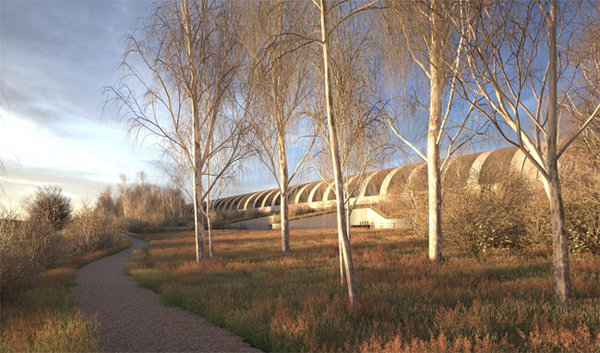Highway authorities and construction projects have got into a bit of trouble lately over tree felling to make way for improvement schemes. Chris Ames assesses the collateral damage.
In the April issue of Highways, Andy Jackson of Leicestershire County Council writes about ADEPT’s Value of Trees project, which helps councils calculate exactly that – i.e. the monetary value of different species according to the ecosystem services they provide, including carbon storage and sequestration, flood management and air pollution removal.
Highway asset management data firm KaarbonTech recently held a ‘Tree SMART Live event’ exploring the importance of efficient tree management and has worked with internationally-renowned Kew Gardens to improve how it risk assesses its tree stock and stores the results.
KaarbonTech says the enhanced method of recording offers identical benefits for the management and maintenance of highway trees and will allow local authorities to collect and store precise data from which to make informed and quick decisions.
It seems a good time to be focusing on the positives, with some authorities attracting controversy for cutting down trees that they see as a barrier to highway management or regeneration work.
A recent report on the Sheffield street tree scandal, where the city council cut down thousands of trees, traced the problem back to the misinterpretation of a 2007 analysis, ‘arising from the fact that the people making the key judgments on design issues were highway engineers not tree specialists’.
More recently, Plymouth City Council felled 110 city centre trees as part of a regeneration project. Council leader Richard Bingley resigned after a court injunction stopped the cull.
But some councils clearly see the value of trees. In March, Buckinghamshire Council served a tree preservation order on the company building the controversial high speed rail line after discovering that HS2 Ltd was cutting back trees in Sheephouse Wood – a 56.9-hectare biological area of Special Scientific Interest.
The council said that ‘with its ancient oak trees, diverse ground flora, breeding birds and uncommon invertebrates, this ancient woodland is a cherished site of local, national and international importance for nature conservation’.
Asked why this was happening, HS2 Ltd said the works were required for safety and technical reasons ‘to protect the bat structure they have decided to construct, and the railway line when it is operational’.
Peter Martin, the council’s deputy cabinet member for HS2, pointed out that it has an agreement with HS2 Limited for 'effective collaboration' but said that despite this, ‘when we asked HS2 for more information and detail about what they are doing at Sheephouse Wood, they have not satisfactorily answered our questions or engaged in any depth about their plans’.
The council says the order served on HS2 Ltd will ensure that the trees cannot be touched for up to six months and give it more time to discuss with the company ‘why they believe such brutal action is warranted, identify alternative options and to mitigate the impact of their works’. It added:’
Preventing the loss of even just one tree in an ancient woodland is worth fighting for.’

HS2 Ltd says Sheephouse Wood is home to several bat species and it had obtained assent from Natural England, which enforces bat protection, to make ‘limited changes’ to the wood. These included pruning and the removal of a small number of trees at risk of falling within the railway area and planting a wider range of smaller trees and shrubs to improve biodiversity.
Its bat protection structure (above) will run alongside the wood for around 1km at a height of up to 10 metres and allow bats to cross the line without being harmed by trains.
Back on the highway network, National Highways has pledged to plant 30 million trees by 2030 as part of its target of reducing its operational emissions to net zero by that date. It says its ‘green spaces’ will contribute 17% of the reduction from 82,000 tonnes of CO2 equivalent during 2020.
In last summer’s annual update, it reported having worked ‘firstly to support the sustainable supply of seeds, secondly to secure internal funding to buy these, and finally to plan where and how we will plant these on our network’. The company has recently advertised a £2.7m contract for a nursery to grow trees from seeds that it will provide.

Picture courtesy of the RHS
While not quite on the scale of HS2, the environmental impact of National Highways’ plans to widen the interchange with the A3 at Junction 10 of the M25 in Surrey have also proved hugely controversial.
The A3 is being widened, including alongside the Royal Horticultural Society (RHS) garden at Wisley (above), and four new free-flowing slip roads built.
The scheme was granted a development consent order (DCO) last year by the then transport secretary, Grant Shapps. National Highways says that to deliver the project, it needs to remove trees and vegetation. Ironically this includes removing trees so it can build a ‘unique’ replacement heathland bridge that will allow riders, walkers and wildlife to cross the A3.
Not all of what National Highways is doing is about making space for a larger junction. It says the majority of the trees being felled are conifers planted for timber production on the original woodland or what used to be heathland. It is removing them to bring back the original woodland and restore ancient and rare heathland.
It says it is ‘enhancing the woodland using selective clearance’, which involves thinning out conifers to improve the abundance of broadleaf, structurally complex woodland that is more in keeping with the historic landscape and is a vital habitat for a wide range of species.
‘Though trees will be removed from these habitats, that is not the same as woodland being lost, quite the opposite, they are being ecologically enhanced.’
The road will be widened into the central reservation as it passes the RHS, which ‘not only protects other important tree specimens along the A3 boundary but also the extensive and vital root structure under them’.
The RHS says it has worked for years to protect Wisley’s trees from the works, with a petition signed by more than 134,000 people having ‘some considerable success’. Earlier proposals would have placed a number of trees within the garden at risk, with several heritage trees threatened by felling or undermining root strength.
A spokesperson says: ‘We have been able to safeguard everything within our boundary, including some giant redwoods, several Champion trees and rare hybrid trees.’
The spokesperson says the RHS was nevertheless ‘saddened at tree loss at the RHS Garden Wisley entrance, as well as elsewhere’.
One controversial aspect of Mr Shapps’ decision was cutting the amount of ‘replacement land’ purchased by National Highways for public amenity. John Goodridge, chair of the Surrey Campaign to Protect Rural England, describes the move as a ‘terrible blow [that] shows disregard for the current damage National Highways are doing to the area’.
He tells Highways: ‘It sounds like National Highways are trying to do the right thing by the countryside and the secretary of state has just ignored the views of the developers and the public.’
The National Policy Statement for National Networks says consent should not be granted for any development that would result in loss or deterioration of irreplaceable habitats, ancient woodland or aged or veteran trees outside ancient woodland, ‘unless the national need for and benefits of the development, in that location, clearly outweigh the loss’.
A newly updated draft national policy statement, currently out to consultation, similarly states that development consent in such circumstances should not be granted ‘unless there are wholly exceptional reasons (for example, where the public benefit would clearly outweigh the loss or deterioration of habitat) and a suitable compensation strategy exists’.
The Junction 10 scheme will result in a loss of 0.4 hectares of ancient woodland in two places. In his decision letter, Mr Shapps said he agreed with the Planning Inspectorate that this ‘would not be sufficiently significant on its own for the DCO not to be made’.
He also noted that the scheme would entail the loss of two veteran trees, with a further nine potentially requiring removal, but also ‘that the Applicant believes that these nine veteran trees would be able to be retained through the use of careful design’.
National Highways says the current position is that seven of the nine are not under threat while two may be lost, depending on the exact alignment of a nearby road.
Jack Taylor of The Woodland Trust tells Highways: ‘Ancient woods are one of the UK’s most biodiverse terrestrial habitats, home to many of the UK's most important and threatened fauna and flora. So it’s vitally important that government agencies, such as National Highways, are protecting them from any further deterioration or loss.’
He adds: ‘Ancient and veteran trees are vitally important on account of their deadwood features, providing life and home to bats, birds, fungi, and many invertebrates. ‘Any loss of these habitats must not be taken lightly. With so many major infrastructure schemes resulting in loss and deterioration of these irreplaceable habitats, we cannot afford to lose any more and our government agencies must do better.’



